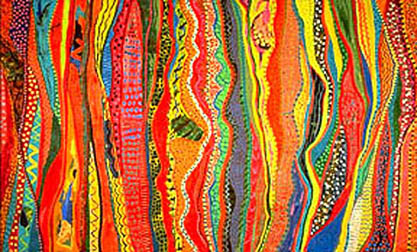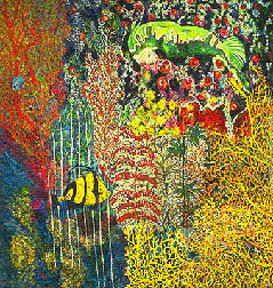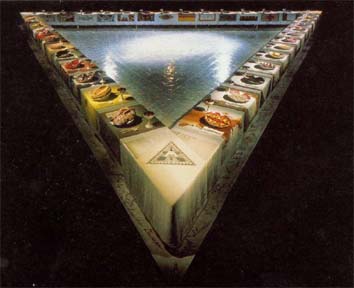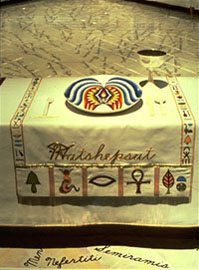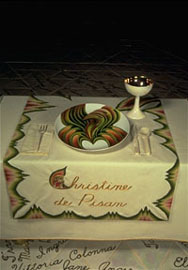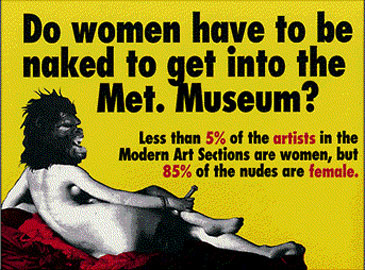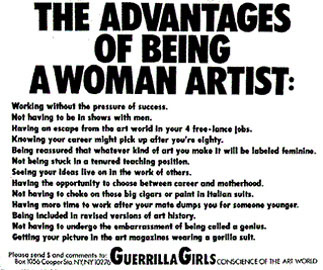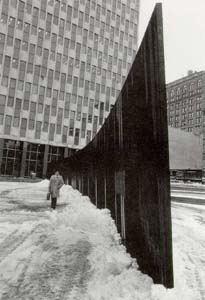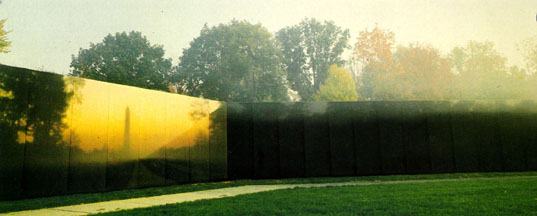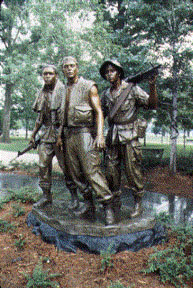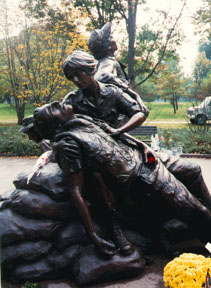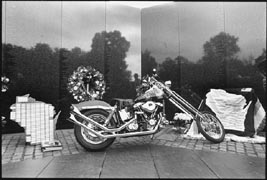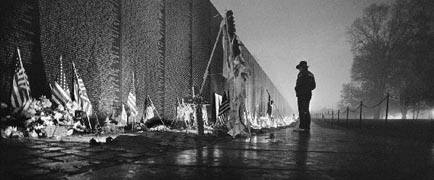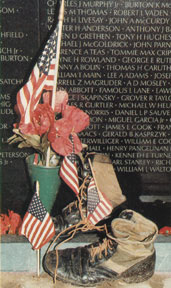.
Trends in PostModern Art
Art of Installation

Jenny Holtzer: "Protect", July- October 1994
|
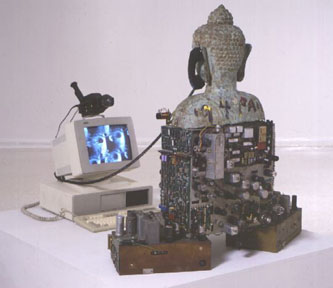
Nam June Paik: Techno Buddha
|
An installation presents
a visualization of 3-dimensionallity, in real time and space. It can
include 2-dimensional mediums (painting, drawing, photography, etc),
but a 3-dimensional element is also necessary for the interaction
of the viewer into the installation space. Video and electronic media
are used frequently. Installation art is often conceptual in
nature. That is, the emphasis is more on ideas than on the
creation of unique objects. For this reason, installation art frequently
incorporates an assembly of "ready made" (manufactured)
objects instead of focusing on the craftsmanship of the artist. (This
is not, however, necessary for the definition of installation art,
as many installation artists create every object in their installation).
|
Sometimes, the artist him or herself
is part of the installation, in which case the installation becomes performance
art.
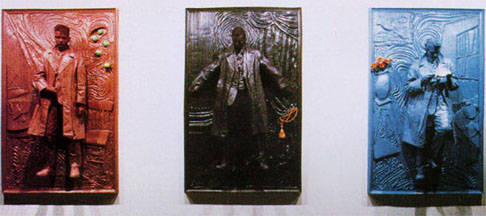
Stephen Taylor Woodrow: "The Living Paintings",
artist and friends at the New Museum of Contemporary Art, NYC,
1988.
Sandy Skogland: Installation Photography
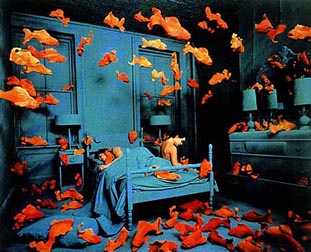
Revenge of the Goldfish, 1981
|

Germs Are Everywhere, 1984
|
Sandy Skoglund is a photographer who consistently uses rooms,
monochromatically painted furniture, actors, an excessive number of animals
or objects and unusual media to create dreamlike scenes. She creates the animals
by hand (ceramic goldfish, bubblegum "germs"), and poses actors
into her photographs to create scenes which open up the possibility of many
interpretations, but which generally reflect on concerns and fantasies of
a post-modern world... most commonly the relationship between humans, suburban
environments and nature.
MultiCulturalism
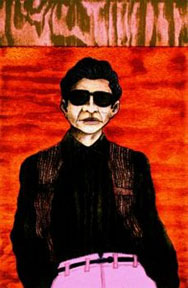
Cesar Martinez: Bato Con Sunglasses
|
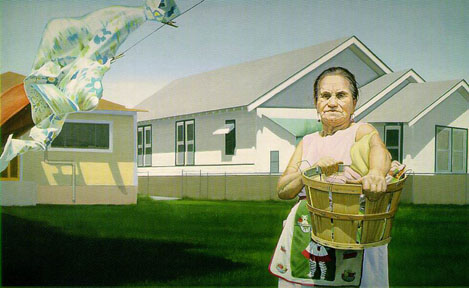
Jesse Trevino: Senora Dolores Trevino, 1982
|
Cesar Martinez is a world-known artist who originates from Laredo and currently
lives and works in San Antonio, Tx. His "Bato con Sunglasses"
is an example from his Bato/Pachuco/Ruca series, a group of portraits and
character studies inspired by life in the barrio. The fictionalized people
depicted in this series are recognizable as "types," but they also come
very much alive as distinctive individuals.
Though Jesse Trevino was born in Monterrey, Mexico, he was raised in San
Antonio with 11 brothers and sisters. He is internationally known for his
realistic images of San Antonio landmarks and his family and friends from
the westside neighborhood. He briefly attended the New York based Student
Art League, but his studies were interrupted when he was drafted into the
Army and was sent to Vietnam, where he was severely wounded by sniper fire.
His right hand (his painting hand) was replaced with a metal hook, but he
learned to paint using his left hand andÊenrolled in an art class at San
Antonio College . He earned a Bachelor of Arts Degree at Our Lady of the
Lake University and a Masters of Studio Arts from the University of Texas
at San Antonio. He became a naturalized citizen of the United States in
1970.
Hung Liu:
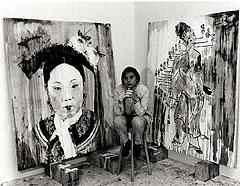
Hung Liu is a Chinese-American artist who addresses the issues of identity,
marginality, feminism, sexism, and racism in her art. Born in Changchun,
China in 1948. As a young woman, Liu was forced to leave her mother to work
in the country's rice fields for four years as part of Mao's Cultural Revolution
re-education effort. At this time, she started secretly photographing and
drawing the farmers and their families. Her formal art training began later
and she eventually graduated and taught at the Central Academy of Fine Art
in Beijing. Here she learned the official style known as social realism
that she so deftly deconstructs today. After arriving in the United States,
Liu received a Master of Fine Arts degree in 1986 at the University of California,
San Diego. She is currently an associate professor of art at Mills College,
Oakland, California.
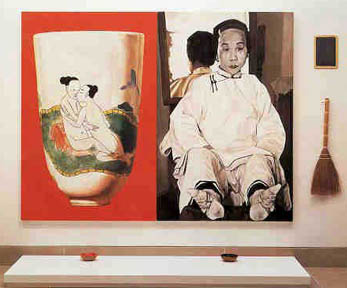
Goddess of Love, Goddess of Liberty, 1989 |
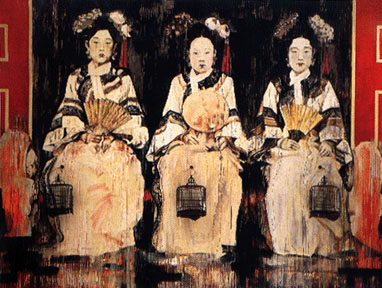
Three Fujins, 1995
|
The ironically-titled Goddess of Love, Goddess of Liberty
contains imagery of women with bound feet, a reoccurring motif in Liu's
work. A woman with bound feet has become Liu's symbol for the suffering
of old China. The work is also expressive of Postmodern feminist concerns
as it refers to historically acceptable abuses of both adult women and female
children.
Three Fujins is one of her most famous works. These women
were the Emporer's concubines. In a film documentary about the artist, Hung
talks about how the mask-like faces of these women appealed to her, how
it seemed to symbolize the roles they were forced to fill, and the irony
of these women being pampered royalty, but at the same time, slaves. She
hung three birdcages on the painting to punctuate her point.
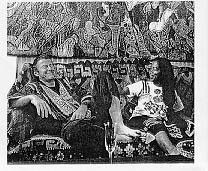
Pacita Abad
The paintings of Philippine artist Pacita Abad are strongly
influenced by her Phillippino background and her world travels. She works
in a style combines expressive painting with the technique of trapunto
(made by quilting and sewing pieces of patterned fabric). The immigrant
experience is presented in crayon-like colors and a simple style that
suggest a child's point of view. Abad is famous for two large mixed media
works, "How Mali Lost Her Accent" and "I Thought the Streets Were Paved
with Gold".
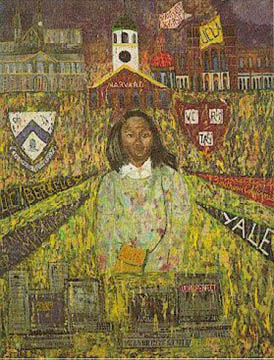 How Mali Lost Her Accent
How Mali Lost Her Accent, 1991 |
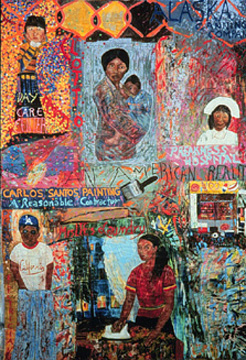 I Thought the Streets Were Paved With Gold
I Thought the Streets Were Paved With Gold, 1991 |
In How Mali Lost Her Accent, Pacita urges caution to the ladder-climbing
of many Asian Americans. A fashionable Asian schoolgirl stands among
images of Ivy League schools and computers; but the portrait hides behind
a confusing drizzle.
In I Thought the Streets Were Paved With Gold, the immigrant
dream of easy riches is replaced with the reality of an unrelenting
cycle of low-paying jobs.
Raised in a politically active family, Pacita was a law student at
the University of Philippines when herÊ involvement in anti-Marcos demonstrations
forced her to flee the country.She supported herself as a seamstress
and typist in California while studying Asian history. After graduating
in 1972, she traversed Asia with her future husband, drawing and painting
through thirty nations. Once married, she moved with her husband's assignments
from international agencies, living in Paris, New York, Bangladesh,
Thailand, and the Sudan. In Asia and Africa, she became fascinated with
indigenous art and crafts that reminded her of those of her homeland.
The bright colors and rich patterns of her more abstract paintings are
also influenced deeply by her world travels.
Faith Ringgold:

Picasso's Studio, 1991
|
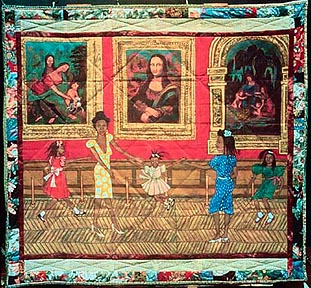
Dancing at the Louvre, 1991
|
Faith Ringgold began her artistic career more than 35 years
ago as a painter. Today, she is best known for her painted story quilts
-- art that combines painting, quilted fabric and storytelling. In addition
to exhibiting her work in major museums across the world, she has written
and illustrated five children's books. In this particular series, Ringgold
combines the Afro-American tradition of quilt-making with an insertion of
black society into the Western (European based) history of Art.
Art And Gender
Judy Chicago: The Dinner Party
|
This is a work of art, triangular in configuration, 48
feet on each side, which employs numerous media, (including ceramics,
china-painting, and needlework) to honor women's achievements. An
immense open table covered with fine white cloths is set with 39 place
settings, thirteen on a side, each commemorating a goddess or historic
personage important woman. Though many are largely unknown, their
names, says the artist, should be familiar to us as the male heroes
whose exploits we absorb from childhood through art, myth, literature,
history, and popular entertainment. The Dinner Party suggests that
these female heroes are equally worthy of commemoration, as are those
hundreds of others (999) whose names are inscribed upon the Heritage
Floor. This lustred porcelain surface serves as the foundation for
The Dinner Party table and the many important human accomplishments
it symbolizes. Ms. Chicago thinks of the piece as a "reinterpretation
of The Last Supper from the point of view of those who've done the
cooking throughout history." |
|
"My idea for The Dinner Party grew out of the
research into women's history that I had begun at the end of the 1960's.
I had undertaken this study in an effort to discover whether women
before me had faced and recorded their efforts to surmount obstacles
similar to those I was encountering as a woman artist. When I started
my investigation, there were no women's study courses, and the prevailing
attitudes toward women's history can best be summed up by the following
story. While an undergraduate at UCLA, I took a course titled the
Intellectual History of Europe. The professor, a respected historian,
promised that at the last class he would discuss women's contributions
to Western thought. I waited eagerly all semester, and at the final
meeting, the instructor strode in and announced: "Women's contributions
to European intellectual history? They made none.' " |
|
The Guerrilla Girls Proclaim War on Sexist
Practices in the Art Establishment:
The Guerrilla Girls are a group of women artists, writers,
performers, film makers and arts professionals who fight discrimination.
They wear gorilla masks to focus on the issues rather than their personalities.
Using humor to convey information, they intend to expose sexism and racism
in the art world.
Public Art and Controvercy
|

Richard Serra's "Tilted Arc", 1981 (now
destroyed)
|
A landmark in public art controvercy occured in 1981, when Richard Serra was
commissioned by the Arts-in-Architecture program of the U.S. General Services
Administration to install his sculpture Tilted Arc in the Federal Plaza in
New York City. The scultpture is a curving wall of raw steel, 120 feet long
and 12 feet high, that carves the space of the Federal Plaza in half. Those
working in surrounding buildings must circumvent its enormous bulk as they
go through the plaza. According to Serra, this is the point, "The viewer becomes
aware of himself and of his movement through the plaza. As he moves, the sculpture
changes. Contraction and expansion of the sculpture result from the viewer's
movement. Step by step the perception not only of the sculpture but of the
entire environment changes."
The sculpture generated controversy as soon as it is erected.
Those against the sculpture (mostly people who work at Federal Plaza) say
that the sculpture interferes with public use of the plaza. They also accuse
it of attracting graffiti, rats, and terrorists who might use it as a blasting
wall for bombs. A public hearing is to determine whether Tilted Arc should
be relocated. Richard Serra testifies that the sculpture is site-specific,
and that to remove it from its site is to destroy it. If the sculpture is
relocated, he will remove his name from it. The public hearing is held in
March 1985. During the hearing, 122 people testify in favor of retaining the
sculpture, and 58 testify in favor of removing it. The jury of five, chaired
by William Diamond, vote 4-1 in favor of removing the sculpture. Serra's appeal
of the ruling fails. On March 15, 1989, during the night, federal workers
cut Tilted Arc into three pieces, remove it from Federal Plaza, and cart it
off to a scrap-metal yard.
The Tilted Arc decision prompts general questions about public
art. The role of government funding, an artist's rights to his or her work,
the role of the public in determining the value of a work of art, and whether
public art should be judged by its popularity are all heatedly debated.
Vietnam War Memorial
The idea for a memorial came from a Vietnam veteran named Jan C. Scruggs.
After watching the film "The Deer Hunter", he organized a group of veterans
to petition the government to fund the first memorial to commemorate the
soldiers who were lost in this unpopular war. Congress authorized the Vietnam
Veterans Memorial in 1980, stating that it would be located prominently
on the National Mall on two acres of Constitution Gardens. Following a contest
involving over 1400 entries, a jury selected the design of Maya Ying Lin
of Athens, Ohio, who at the time was a 21-year old architectural student
at Yale University. The Wall was built in 1982 and immediately drew criticism
from various veterans groups. Because of its minimalist design and its use
of black granite stone which directly sliced into the landscape, the wall
was dubbed by its critics "the black gash of shame" or a "giant
tombstone."
In an attempt to appease those who wanted a more heroic and
representational memorial, it was decided to add Frederick Hart's Statue of
the Three Servicemen to the overall design .in 1984. Nine years later, in
1993, the Vietnam Women's Memorial was added women to honor the women who
served and sacrificed during the Vietnam War.
Despite the original controvercy, The Wall is the most beloved
of the memorials, and people who come to visit it rarely leave without being
touched by it. Many leave momentos of letters, dogtags, flags, and personal
possessions of those they knew who died in the Vietnam war. A museum was set
up to collect and display these items.
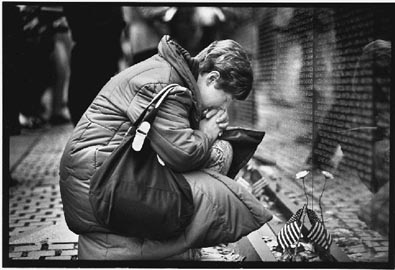
Photo above from Larry Powell's book
"Hunger of the Heart: Communion at the Wall"
|
Letter to a Wall By Racheline Maltese
"I am a story teller. I came here to write about
this place, but that is suddenly not what I am doing. I cried here at
your wall today, but I don't know a single person on it. Every time
I see a name that reminds me of one I know, I twitch. I do know people
who were there. I do know how easily things could be reversed. And I
don't know what I'd do without these people. So, I guess I need to thank
you for them. I am only 21. I do not remember the war when it was happening.
I did not learn about it in school. To see these men and women with
their shirts and flags shakes me. Seeing the things people have left
here shakes me. A picture of Jimi Hendrix, a bottle of Seagrams 7, a
pack of cigarettes have reduced me to tears. I wonder if you watch us,
if you see this. If you'd like to say thank you for these gifts. I wonder
if we mourn for you or for ourselves. I came here recently before dawn,
and it was empty. The wind was knocking over your flowers, and squirrels
were playing on top of your black ledge. I stood at the apex of a wall,
I guess at the apex of a war; and it started to pour. I just stood there.
I live near here so I visit often now. Thank you for giving me something
to understand...or to try to; these days, there is very little I understand.
I can give you nothing but these words. But I promise I'll bring my
kids here one day, make them remember, make it somehow more than just
another story". |
Memorial Statistics
| Each of the walls is 246' 8" long. They meet at an angle
of 125 degrees, pointing exactly to the northeast corners of the Washington
Monument and Lincoln Memorial. At their vertex the walls are 10' 1 1Ú2"
in height. The stone for the walls, safety curbs and walkways is black
granite quarried near Bangalore, India. The names and inscriptions were
gritblasted, using stencils produced through a photographic process. The
names were arranged chronologically from computer tape of the official
Vietnam casualty list. The letters are about 1/2" high. A total of
57,939 names were originally inscribed on the walls.The date "1959" is
engraved on the upper left hand corner of the first panel before the first
name. At the lower right corner of the first panel of the west side, we
find the date "1975." When the memorial was finished, in 1982, some people
expressed surprise at those dates. The Vietnam War, they thought, started
in either 1964 or 1965 and ended in 1973 with the withdrawal of troops
following the Paris Peace agreement. The origins of the conflict go back
much earlier in the century, however. The truth is that 1959 and 1975
do not even begin to encompass the years of grief brought to American
families by deaths in the Vietnam War. |
|
|













